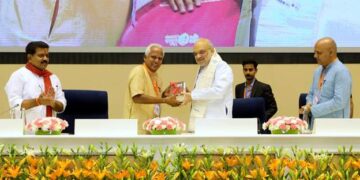By: Mohd Amin Mir
India’s vast rural landscape holds the key to its agrarian economy, yet its land records remain trapped in a legacy of confusion, conflict, and clerical decay. While cities march ahead with digital real estate systems, our villages still rely on handwritten jamabandis, oral testimonies, and crumbling tatima maps. The time has come to bridge this gap—not through expensive satellite surveys or bureaucratic overhauls, but through a trial-based digital land settlement model that is cost-effective, participatory, and rooted in rural realities.
Why Focus on Villages First?
Urban centers, with their dense populations and layers of construction, pose immense challenges for ground-level land settlement. In contrast, rural areas—with clearer boundaries, fewer buildings, and active community memory—offer a perfect testing ground for digitized land governance.
Key advantages of starting with villages:
Low Population Density: Easier to identify physical boundaries with less overlapping of ownership claims besides Active Oral History as villagers often know exact plot histories.
There is also Administrative Simplicity as Panchayats can facilitate verification.
The Legacy System: Why Reform is Urgent
The current land record system in many states, especially in Jammu & Kashmir, continues to depend on outdated colonial structures. These systems suffer from:
Decades-old jamabandis and shajras, missing records for oral gifts, decrees, and tenancy claims, no demarcation of fragmented holdings or family partitions, lack of correlation between physical possession and legal title.
As a result, the revenue courts are overwhelmed, disputes proliferate, and rightful ownership remains buried in ambiguity. A digital trial settlement offers a fast, transparent, and legally sound alternative.
A Simple, Ground-Level Model for Digital Land Settlement
The proposed trial-based model is not driven by drones or high-end GIS systems. It relies on grassroots manpower—patwaris—empowered with modern tools already available in every smartphone.
Key tools:
Google Maps / Google Earth: To trace and overlay plot shapes
Google Lens: To read physical markers, house numbers, crop types
Smartphone GPS: To record exact coordinates
Mobile Camera: To photograph possession and claimants
Basic GIS Apps: For creating digital tatima maps on-the-go
Step-by-Step Process: A Field Manual for Patwaris
- Preliminary Village Selection
Choose 10–15 pilot villages per district with population under 3000, low land litigation ratio and cooperative panchayat leadership.
Ground Verification and Data Collection:
Patwaris will visit each survey number physically, Record owner, possessor, and tenant details and note current land use (agriculture, pasture, residential). They will also take geo-tagged photos and plot coordinates, prepare rough jamabandi and sketch tatima maps and use Google Maps to trace parcel outlines. Further, they will scan old documents or house inscriptions with Google Lens
- Public Verification and Grievance Redressal
For this purpose, conduct open darbars for villagers to verify and contest records, resolve objections through on-spot evidence and also allow 30-day window for written feedback
- Preparation of Draft Digital Record
Consolidate data into a digital jamabandi, overlay rough maps onto village layout via Google Maps, mark boundaries with shared digital signatures (GPS + photos).
Legal Viability and Policy Framework
To avoid future legal challenges, the government should issue notifications recognizing these digital trial settlements as preliminary records with a validity of 3–5 years, subject to correction through appellate procedure.
Recommended safeguards:
Treat records as “Interim Verified Land Register”
Allow for public and legal objections within defined timeframes
Mark parcels with disputed or undocumented claims for further scrutiny Integrate Agrarian Reforms Act impacts (e.g., ceiling surplus, tenancy protection)
International Best Practices: Lessons from the Field
Several countries have shown that rural digital settlement is not only possible but transformative:
While Rwanda Digitized over 10 million plots using handheld GPS and public meetings, Bangladesh used Android apps to record rural holdings, cutting disputes by 60% and Ethiopia created participatory maps with women and tenants included.
India, with its tech-savvy youth and deep panchayat structure, is even better equipped to execute such a program successfully.
Major Benefits of the Digital Trial Settlement Model
- Transparency and Trust
Open process reduces manipulation and community involvement ensures accuracy.
- Low Cost, High Impact
Uses existing government staff and free tools and avoids high-cost satellite or drone surveys.
- Empowered Revenue Staff
Patwaris become proactive field investigators, not just record clerks
- Dispute Prevention
Early mapping avoids future encroachments and conflicts
- Faster Future Settlements
Establishes a template that can be rapidly scaled up
Policy Recommendations for Revenue Departments
To ensure a successful launch, state and UT revenue departments must:
Launch a Pilot Notification: Authorize 10 trial villages per tehsil
Train Revenue Staff: Conduct 3-week crash courses on digital tools
Establish Support Teams: Include panchayat officials, teachers, and data volunteers
Create a Monitoring Cell: Independent officers to audit accuracy
Engage Citizens: Launch an app or portal for viewing and submitting suggestions
Anticipated Challenges—and How to Beat Them
- Resistance from Local Power Structures
Some may fear exposure of encroachments
Solution: Legalize appeals, build awareness campaigns
- Digital Illiteracy Among Villagers
Solution: Use paper maps alongside digital displays for clarity
- Legal Pushback from Courts
Solution: Notify the process as “preliminary documentation” pending final entries
Conclusion: From Dusty Registers to Digital Clarity
India’s rural land governance can no longer afford to be paper-bound, ambiguous, and dispute-prone. A trial digital land settlement—led by trained patwaris using Google tools and mobile apps—offers a new direction. It is simple, transparent, and scalable.
Rather than wait for sweeping reform from the top, the revenue department should act decisively at the grassroots. Let the village become the laboratory of justice, digitization, and good governance.
The transition from files to phones, from courtrooms to community halls, and from suspicion to verification, begins with one small step: a digital settlement pilot that listens to the people, reflects the land, and respects the law.
The writer is a legal analyst and columnist writing on land reform, revenue law, and rural governance. Feedback can be shared at: miramin354@gmail.com.




